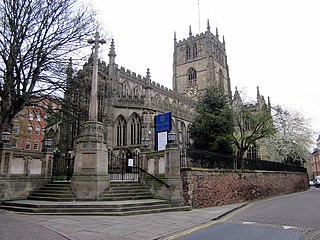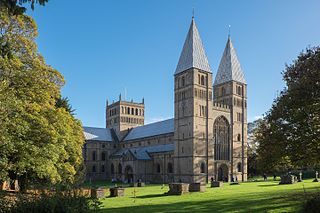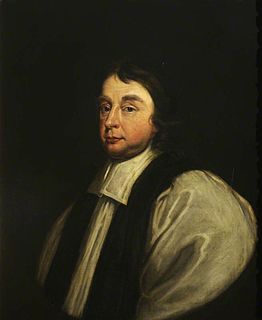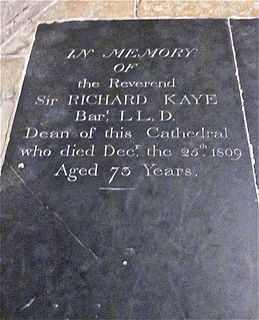Samuel Crowbrow (also Crowborough, Croborrow and Crobrow) DD (born 1646) was Archdeacon of Nottingham from 1685–1690 until deprived of the position as a non-juror.
The Archdeacon of Nottingham is a senior ecclesiastical officer in the Church of England Diocese of Southwell and Nottingham, who exercises supervision of clergy and responsibility for church buildings within the Archdeaconry of Nottingham.

The nonjuring schism was a split in the Anglican churches of England, Scotland, and Ireland in the aftermath of the Glorious Revolution of 1688, over whether William III and Mary II could legally be recognised as sovereigns.
He was the son of Hastings Crowbrow of Repton, Derbyshire, baptised on 2 November 1646 and attended Repton School.

Repton School is a co-educational independent school for boarding and day pupils in Repton, Derbyshire, England.
He matriculated B.A. from Queens' College, Cambridge in 1668, [1] and was awarded MA in 1671, and Doctor of Divinity in 1683.

Queens' College is a constituent college of the University of Cambridge, England. Queens' is one of the oldest and the largest colleges of the university, founded in 1448 by Margaret of Anjou, and has some of the most recognisable buildings in Cambridge. The college spans both sides of the river Cam, colloquially referred to as the "light side" and the "dark side", with the Mathematical Bridge connecting the two.
He held the Prebend of Bugthorpe in York Minster 1678–1680, the Prebend of Wighton in York Minster 1680–1690 and the Prebend of North Muskham in Southwell Minster from 1678. He was also master of Bawtry Hospital in Yorkshire.
The Hospital of St Mary Magdalene, Bawtry was a charity established in Bawtry in the thirteenth century. The surviving chapel building is now a masonic lodge and Grade II listed.
He was rector of St George's Church, Barton in Fabis and Vicar of St Mary's Church, Nottingham 1686–1690. Archdeacon of Nottingham 1685–1690. [2]

St. George's Church is a parish church in the Church of England in Barton in Fabis, Nottinghamshire. It is part of an informal grouping of five churches that are known collectively as "The 453 Churches" as they straddle the A453. The other churches in the group are:

The Church of St Mary the Virgin is the oldest religious foundation in the City of Nottingham, England, the largest church after the Roman Catholic Cathedral in Nottingham and the largest mediaeval building in the city.
He lost his position for refusing to take the oaths of allegiance to King William and Queen Mary.
This page is based on this
Wikipedia article Text is available under the
CC BY-SA 4.0 license; additional terms may apply.
Images, videos and audio are available under their respective licenses.
John Chishull or John de Chishull was Lord Chancellor of England, Bishop of London, and Lord High Treasurer during the 13th century. He also served as Dean of St. Paul's.

Southwell is a town in Nottinghamshire, England, the site of Southwell Minster, the cathedral of the Anglican Diocese of Southwell and Nottingham covering Nottinghamshire. Its population of under 7000 increased to 7,297 at the 2011 Census. The origin of name is unclear. The town lies on the River Greet, about 14 miles (22 km) north-east of Nottingham. Other historic buildings include the prebendal houses in Church Street and Westgate, and the Methodist church, which has a right of way running under it, so that the upper floor seats more than the lower. The workhouse, built in 1824, was a prototype for many others. It is owned by the National Trust and shows its appearance and conditions in the 19th century. Behind the Minster is a partly ruined palace, once a residence of the Archbishop of York. It includes the recently restored State Chamber, Cardinal Wolsey's former dining room, and gardens amongst the ruins.

Southwell Minster is a minster and cathedral, in Southwell, Nottinghamshire, England. It is situated six miles from Newark-on-Trent and thirteen miles from Mansfield. It is the seat of the Bishop of Southwell and Nottingham and the Diocese of Southwell and Nottingham.

John Lake was a 17th-century Bishop of Sodor and Man, Bishop of Bristol and Bishop of Chichester in the British Isles.

Thomas White (1628–1698) was Bishop of Peterborough from 1685 to 1690.
George Wilkins, D.D. was born in May 1785 in Norwich. He served as a priest in the Church of England and was Archdeacon of Nottingham. He died on 13 August 1865.
John Gray Richardson (1849–1924) was a priest in the Church of England.

John Williams was an English Bishop of Chichester.

William Stanley (1647–1731) was an English churchman and college head, Master of Corpus Christi College, Cambridge, Archdeacon of London and Dean of St Asaph.
Drue Cressener (1642?-1718) was an English clergyman and theological writer, known as an interpreter of the Apocalypse.

Sir Richard Kaye, 6th Baronet, FRS was an English churchman and scientist. He was Dean of Lincoln from 1783, and inherited the baronetcy from his elder brother Sir John Lister Kaye, 5th Baronet in 1789.
Denis Granville was an English non-juring cleric, Dean of Durham and then Jacobite exile.
John Barret (1631–1713) was an English Presbyterian cleric and a religious writer prominent in the controversies of his time.

The Venerable John Eyre was Archdeacon of Nottingham
The Venerable William Pearson LL.D was Archdeacon of Nottingham from 1690 to 1715.
Hamo was a 12th- and 13th-century English cleric. He was the Diocese of York's dean, treasurer, and precentor, as well as the archdeacon of East Riding.
Walter Marshall Browne was Archdeacon of Rochester from 1932 to 1951.
Heneage Dering, LL.D (1665–1750) was an eminent Anglican priest in the first half of the 18th century. He became Dean of Ripon and was known also as a Latin poet.
Barnabas Long or Longe was Archdeacon of Cleveland from 1683 to 1685.












